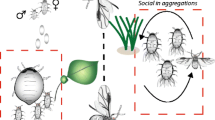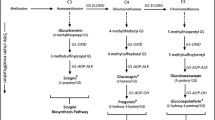Abstract
It is becoming increasingly appreciated that the structure and functioning of ecological food webs are controlled by the nature and level of plant chemicals. It is hypothesized that intraspecific variation in plant chemical resistance, in which individuals of a host-plant population exhibit genetic differences in their chemical contents (called ‘plant chemotypes’), may be an important determinant of variation in food web structure and functioning. We evaluated this hypothesis using field assessments and plant chemical assays in the tansy plant Tanacetum vulgare L. (Asteraceae). We examined food webs in which chemotypes of tansy plants are the resource for two specialized aphids, their predators and mutualistic ants. The density of the ant-tended aphid Metopeurum fuscoviride was significantly higher on particular chemotypes (borneol) than others. Clear chemotype preferences between predators were also detected. Aphid specialist seven-spotted ladybird beetles (Coccinella septempunctata) were more often found on camphor plants, while significantly higher numbers of the polyphagous nursery web spider (Pisaura mirabilis) were observed on borneol plants. The analysis of plant chemotype effects on the arthropod community clearly demonstrates a range of possible outcomes between plant-aphid-predator networks. The findings help to offer a deeper insight into how one important factor—plant chemical content—influences which species coexist within a food web on a particular host plant and the nature of their trophic linkages.



Similar content being viewed by others
References
András CsD, Kapás Á, Bartha Z, Salamon R, Cs Csajági, Székely G, Sz Salamon, György É (2009) Volatile extraction from fennel (Foeniculum vulgare Mill.). J Oil Soap Cosm 58:66–72
Baldwin IT (2006) Volatile signaling in plant–plant interactions: ‘talking trees’ in the genomics era. Science 311:812–815
Barabási AL, Albert R (1999) Emergence of scaling in random networks. Science 286:509–512
Barbour MA, Rodrigues-Cabal MA, Wu ET, Julkunen-Tiitto R, Ritland CE, Miscampbell AE, Jules ES, Crutsinger GM (2015) Multiple plant traits shape the genetic basis of herbivore community assembly. Funct Ecol. doi:10.1111/1365-2435.12409 (in press)
Begon M, Townsend CR, Harper JL (2006) Ecology: from individuals to ecosystems, 4th edn. Blackwell, Oxford
Benedek K, Bálint J, Salamon VR, Kovács E, Ábrahám B, Cs Fazakas, Loxdale HD, Balog A (2015) Tansy plant (Tanacetum vulgare L.) chemotype determines aphid genotype and its associated predator system. Biol J Linn Soc 114:709–719
Brink PJV, Braak CJFT (1999) Principal response curves: analysis of time-dependent multivariate responses of biological community to stress. Toxicol Chem 18(2):138–148
Bruinsma M, Posthumus MA, Mumm R, Mueller MJ, van Loon JJ, Dicke M (2009) Jasmonic acid-induced volatiles of Brassica oleracea attract parasitoids: effects of time and dose, and comparison with induction by herbivores. J Exp Bot 60:2575–2587
Bukovinszky T, van Veen FF, Jongema Y, Dicke M (2008) Direct and indirect effects of resource quality on food web structure. Science 319:804–807
Burghardt KT, Schmitz OJ (2015) Influence of plant defenses and nutrients on trophic control of ecosystems. Ch. 9. In: Hanley T, La Pierre K (eds) Trophic ecology: bottom-up and top-down interactions across aquatic and terrestrial systems. Cambridge University Press, Cambridge
Crutsinger GM, Collins MD, Fordyce JA, Gompert Z, Nice CC, Sanders NJ (2006) Plant genotypic diversity predicts community structure and governs an ecosystem process. Science 313:966–968
Dicke M, Baldwin IT (2010) The evolutionary context for herbivore-induced plant volatiles: beyond the ‘cry for help’. Trends Plant Sci 15(3):167–175
Dunne JA, Williams RJ, Martinez ND (2002) Food-web structure and network theory: the role of connectance and size. Proc Natl Acad Sci USA 99:12917–12922
Flatt T, Weisser WW (2000) The effects of mutualistic ants on aphid life history traits. Ecology 81:3522–3529
Gols R, Wagenaar R, Bukovinszky T, van Dam NM, Dicke Bullock JM, Harwey JA (2008) Genetic variation in defence chemistry in wild cabbage affects herbivores and their endoparasitoids. Ecology 89(6):1616–1626
Hare JD (1992) Effects of plant variation on herbivore-natural enemy interactions. In: Fritz RS, Simms EL (eds) Plant resistance to herbivores and pathogens: ecology, evolution, and genetics. University of Chicago Press, Chicago, pp 278–300
Harvey JA, van Dam NM, Gols R (2003) Interactions over four trophic levels: food plant quality affects development of a hyperparasitoid as mediated through a herbivore and its primary parasitoid. J Anim Ecol 72:520–531
Harvey JA, van Dam NM, Witjes LMA, Soler R, Gols R (2007) Effects of dietary nicotine on the development of an insect herbivore, its parasitoid and secondary hyperparasitoid over four trophic levels. Ecol Entomol 32:15–23
Holopainen M (1989) A study on the essential oil of tansy (Tanacetum vulgare L.). University of Helsinki, Finland
Holopainen M, Hiltunen R, Lokki J, Forsen K, Schantz MV (1987a) Model for the genetic-control of thujone, sabinene and umbellulone in Tansy (Tanacetum vulgare L). Hereditas 106:205–208
Holopainen M, Hiltunen R, von Schantz M (1987b) A study on tansy chemotypes. Planta Med 53:284–287
Huang M, Abel C, Sohrabi R, Petri J, Haupt I, Cosimano J, Gershenzon J, Tholl D (2010) Variation of herbivore-induced volatile terpenes among Arabidopsis ecotypes depends on allelic differences and sub cellular targeting of two terpene synthases, TPS02 and TPS03. Plant Physiol 153:1293–1310
Johnson MTJ (2008) Bottom-up effects of plant genotype on aphids, ants and predators. Ecology 89:145–154
Johnson MTJ, Agrawal AA (2005) Plant genotype and environmental interact to shape a diverse arthropod community on evening primrose (Oenothera biennis). Ecology 86:874–885
Jordán F, Gjata N, Mei S, Yule CM (2012) Simulating food web dynamics along a gradient: quantifying human influence. PLoS One 7(7):e40280. doi:10.1371/journal.pone.0040280
Kapás Á, András CsD, Dobre TG, Vass E, Székely G, Stroescu M, Lányi Sz, Ábrahám BÉ (2011) kinetics of essential oil separation from fennel by microwave hydro distillation (MWHD). UPB Sci Bull Series B 73(4):127–130
Keskitalo M, Linden A, Valkonen J (1998) Genetic and morphological diversity of Finnish tansy (Tanacetum vulgare L., Asteraceae). Theor Appl Genet 96:1141–1150
Linhart YB, Keefover-Ring K, Mooney KA, Breland B, Thompson JD (2005) A chemical polymorphism in a multitrophic setting: thyme monoterpene composition and food web structure. Am Nat 166:517–529
Mantyla E, Tero K, Erkki H (2004) Attraction of willow warblers to sawfly damaged mountain birches: novel function of inducible plant defences? Ecol Lett 7:915–918
Mehrparvar M, Mahdavi Arab N, Weisser WW (2013) Diet-mediated effects of specialized tansy aphids on survival and development of their predators: is there any benefit of dietary mixing? Biol Control 65:142–146
Mestre L, Bucher R, Entling MH (2014) Trait-mediated effects between predators: ant chemical cues induce spider dispersal. J Zool 293(2):119–125
Mooney KA, Halitschke R, Kessler A, Agrawal AA (2010) Evolutionary trade-offs in plants mediate strength of trophic cascades. Science 327:1642–1644
Mumm R, Dick M (2010) Variation in natural plant products and the attraction of bodyguards for indirect plant defence. Can J Zool 88(7):628–667
Pierre PS, Jansen JJ, Hordijk CA, van Dam NM, Cortesero AM, Dugravot S (2011) Differences in volatile profiles of turnip plants subjected to single and dual herbivory above- and belowground. J Chem Ecol 37:1–10
Poelman EH, van Loon JJA, Dicke M (2008) Consequences of variation in plant defense for biodiversity at higher trophic levels. Trends Plant Sci 13:534–541
R Core Team (2013) R: a language and environment for statistical computing. R Foundation for Statistical Computing, Vienna. ISBN 3-900051-07-0. http://www.R-project.org. Accessed 7 June 2014
Rasmann S, Tobias G, Köllner J, Degenhardt IH, Stefan T, Ulrich K, Jonathan G, Ted CJ (2005) Recruitment of entomopathogenic nematodes by insect-damaged maize roots. Nature 434:732–737
Rohloff J, Mordal R, Dragland S (2004) Chemotypical variation of tansy (Tanacetum vulgare L.) from 40 different locations in Norway. J Agric Food Chem 52:1742–1748
Roth S, Knorr C, Lindroth RL (1997) Dietary phenolics affects performance of the gypsy moth (Lepidoptera: Lymantriidae) and its parasitoid Cotesia melanoscela (Hymenoptera: Braconidae). Environ Entomol 26:668–671
Runyon JB, Mescher MC, De Moraes CM (2006) Volatile chemical cues guide host location and host selection by parasitic plants. Science 313:1964–1967
Schmitz OJ (2008) Herbivory from individuals to ecosystems. Annu Rev Ecol Evol Syst 39:133–152
Schmitz OJ (2010) Resolving ecosystem complexity. Monographs in population biology. Princeton University Press, Princeton
Snoeren TAL, Kappers IF, Broekgaarden C, Mumm R, Dicke M, Bouwmeester HJ (2010) Natural variation in herbivore-induced volatiles in Arabidopsis thaliana. J Exp Bot 61:3041–3056
Soler R, Harvey JA, Kamp AFD, Vet LEM, Van der Putten WH, Van Dam NM, Stuefer JF, Gols R, Hordijk CA, Bezemeret TM (2007) Root herbivores influence the behaviour of an aboveground parasitoid through changes in plant-volatile signals. Oikos 116:367–376
Stadler B, Dixon AFG (2008) Mutualism: ants and their insect partners. Cambridge University Press, New York
Van der Putten WH, Vet LEM, Harvey JA, Wäckers FL (2001) Linking above- and belowground multitrophic interactions of plants, herbivores, pathogens, and their antagonists. Trees 16:547–554
Whitham TG, Gehring CA, Lamit LJ, Wojtowicz T, Evans LM, Keith AR, Smith DS (2012) Community specificity: life and afterlife effects of genes. Trends Plant Sci 17:271–281
Wolf VC, Gassmann A, Clasen BM, Smith AG, Muller C (2012) Genetic and chemical variation of Tanacetum vulgare in plants of native and invasive origin. Biol Control 61:240–245
Acknowledgments
This research was founded by the Institute of Research Programs of the Sapientia University, grant no. 1/13/05.01.2012. The authors declare no conflict of interest.
Author contribution statement
W. W. W. and A. B. conceived the experiments. A. B., K. B. and J. B. designed the experiments. A. B., K. B., J. B., R. V. S. and M. M. performed the experiments. S. E. Z., W. W. W., O. J. S. and A. B. analysed the data. A. B., W. W. W. and O. J. S. wrote the manuscript. S. E. Z. provided editorial advice.
Author information
Authors and Affiliations
Corresponding authors
Additional information
Communicated by Nina Farwig.
Electronic supplementary material
Below is the link to the electronic supplementary material.
Rights and permissions
About this article
Cite this article
Bálint, J., Zytynska, S.E., Salamon, R.V. et al. Intraspecific differences in plant chemotype determine the structure of arthropod food webs. Oecologia 180, 797–807 (2016). https://doi.org/10.1007/s00442-015-3508-y
Received:
Accepted:
Published:
Issue Date:
DOI: https://doi.org/10.1007/s00442-015-3508-y




